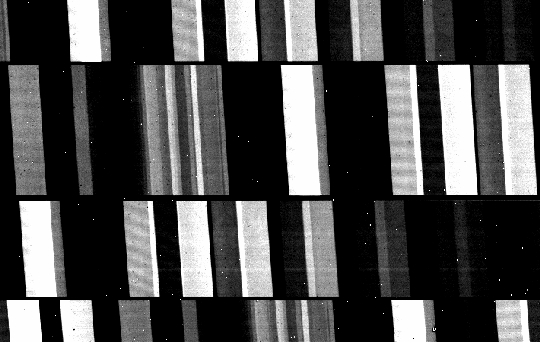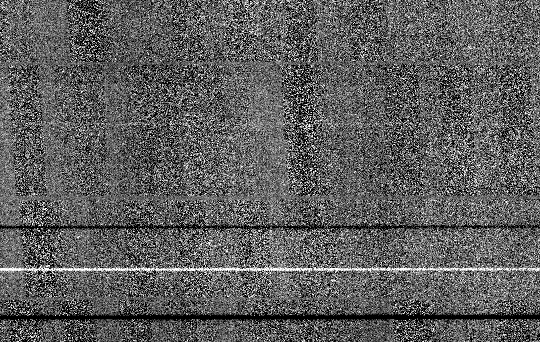Spectrophotometric Observing
Strategies
Observers attempting high-precision spectrophotometry with MOSFIRE
should understand that there are a couple of limiting factors:
the CSU bar may be re-positions to an accuracy of 0.02 arcsec on
the sky, and there is fringing present in the night sky
lines. However, observers can achieve higher precision on masks
(typically two a night) by using the strategies described
below. These strategies were developed for observers acquiring
spectrophotometric data of relatively bright stars, 6-10
magnitudes at K band. The strategies described below not only
address mitigation of CSU motions and fringing, but also how to
observe relatively bright targets. If you have questions please
contact your support astronomer.
The strategies presented here are based on feedback from observing teams with
special thanks to Drs. Ian Crossfield and Avi Mandell. Please see Dr. Crossfield's Appendix A in Warm Ice Giant GJ
3470b for more details concerning some recomendations.
- Obtain dome flats for a mask immediately before or after
the mask's science exposures.
- It is Important not to move the CSU bars between
calibrations and science exposures.
- CSU bar positions are repeatable to 0.02" on the sky
(McLean et al 2012) or roughly 3% of a typical 0.7" wide
slit.
- A two-mask observing example:
- Acquire arcs and flats with the first mask in the
afternoon
- Focus using autofoc (see below)
- Acquire science observations with the first
mask
- Configure CSU for the second target
- Acquire science observation with the second
mask
- In the morning, acquire arcs and flats with the
second mask
- Use Autofoc instead of MIRA to focus the telescope
- Tell the OA and SA! It is important to clearly communicate
the need to run autofoc instead of MIRA to your OA and
SA on duty; otherwise, mira is used by default
- Running MIRA will move the CSU bars because we
image the field to measure telescope focus using
MOSFIRE. You want to avoid moving the CSU bars
- Autofoc will put the telescope close to the nominal
focus using the guide camera. This method is good enough for
spectrophotometric work with MOSFIRE.
- Avoid placing the target at the border of two CSU bars.
- You can do this by simply centering an object between
the two circular regions markers overlayed on the imaged
displayed in ds9. The two green circles identify the middle
edges of the slits.
- Use the command-line script nbfilt to image the field so that you
don't cause persistence on the detector due to over-illumination.
- Nod the telescope during your spectroscopic observing
sequence to reduce fringing effects.
- Nod the telescope by a few arcsecs using the standard
observing pattern "mask-nod"
- Employing pair subtraction of the images acquired
at the two nod positions will
minimize fringing effects.
- Please see below for more details on fringing.
- De-focus the telescope
- Set the telescope focus to +200 microns from the
optimal focus
- Set the guider focus to 13.8 (nominal is 14.0)
- This should improve exposure efficiencies by 2/3 as
it will keep the star from saturating in short
exposures. Please see telescope focusing below.
Acquiring calibrations for wide slits (+2.0") is a manual procedure.
It is recommended that you have two versions of your slitmask. One is
the science mask with 10-15 arcsec wide slits. A second mask has
the same design, but the slits are narrow (0.7").
The mask with narrow slits is used to obtain arclamps so that a
rough wavelength solution may be obtained for your
program. These calibrations are completed like normal masks
and your SA can walk you through the process.
Your wide slitmask requires that you acquire flats
manually. Please see the exposure recomendations for wide
slits for details on setup and a procedure for
acquisition.
Fringing
First identified by Dr Ian Crossfield and his team( Please see Appendix A of Warm Ice Giant GJ
3470b ), observers detect MOSFIRE fringing in spectroscopic
mode of night sky lines when slits are relatively large (i.e.
greater than 2.0 arcsec ). Dr. Crossfield determined that in
K-band, the fringes reach a maximum (slit-width-dependent)
amplitude of roughly 4 ADU/s/arcsec. They observed that the
amplitude, spatial frequency in the slit direction,
orientation, and phase of the fringes all vary both spatially
and temporally. Fringing with MOSFIRE is problematic if the
fixed position or "stare" mode is used ( a common strategy
employed by exoplanet observers). Instead, Keck Observatory
nodding precision is very accurate and repeatable, and thus
nodding the telescope during observing can minimize fringing effects.
In the
image below, there are four slits visible. Each of the four
slits has a set of night sky lines and because the width of
the slit was 15 arcsec, the night sky lines are
parallelograms. The fringing is the sinusoidal pattern evident
when looking from top to bottom on a night sky line.

Below is a line plot of prominent fringing
along one of the brighter night sky lines from
the top to the bottom. Monochromatic
emission from telluric OH lines may be causing fringing on the
order of 50 ADUs peak-to-valley. The plot below shows
relatively larger fringing with an amplitude of 250 ADUs.

Below is an image of the difference of a nod pair which shows
that the fringing is well subtracted. Spectra of a couple of objects are
visible in the differenced pair of images.

On 31 August 2013, we acquired images of a PSF star with the
telescope focused between the optimal focus (0.64) and a
de-focused value of 1.14 mm. Dr. Avi Mandell analyzed the MOSFIRE PSF out-of-focus images and
found that the drop in the peak flux is 2/3 and the PSF broadens
by about a factor of 2.5 when the telescope is de-focused by 200
microns. The image below displays the in and out-of-focus images
and horizontal cuts through the diameter of
the psf. Three is slight doughnut shape at +200 microns, but the PSF exhibits a
mostly flat topped profile (red) relative to the in-focus image (black).
CONCLUSION: we can defocus the telescope by +200
microns and improve the on-sky efficiency of the observations
without impacting the high precision spectrophotometric
observations.
With the telescope de-focused, we
also determined the best focus for the guide camera, which needs
to have a good focus to maintain guiding. Guider focus should be
set to the following values for
different telescope focus offsets. Values listed in bold font
are offsets that work well.
Tel Foc
offset
(microns) | Guider
Focus
(steps) |
|---|
| Optimal | 14.00 |
| +100 | 13.90 |
| +200 | 13.80 |
| +300 | 13.64 |
| +400 | 13.54 |
| +500 | 13.46 |



